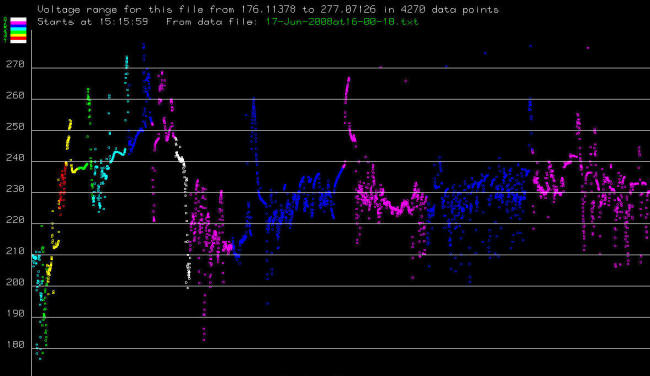RIKLBLOG
|
| Tomorrow |
| 17 June 2008 |
| Yesterday |
| Index |
| Eventide |
| SETI League |
| PriUPS Project |
| Bonus! |
| Contact |


My Commute As A Voltage Graph
Many people would characterize their commute by length, location, route, time, or traffic conditions. How unimaginative! Below you can see the voltage of my daily commute, or at least the initial segment, in which I travel from home to work.
Starting at the left, when I leave my house, the voltage is around 210, reducing to about 180 as I accelerate out of my driveway. I have a short, uphill segment which is tough on the Prius battery, and you can see its SOC ("state of charge") change from five bars (light blue) to four (green) to three (yellow) and briefly to two (red) before I start downhill and the battery starts re-charging. Eventually it attains six bars (dark blue), and hits almost 280 volts when I have to brake for a stop sign. The battery continues to charge, hitting seven bars (magenta) and finally 8 bars, full charge (white), as I reach the bottom of the hill.
Once at the bottom of the hill, I'm driving on more or less level ground for the rest of the commute, and the Prius SOC indicator alternates between 7 (magenta) and 6 (dark blue) until I reach my destination. My graph is more colorful and, at least as far as voltage is concerned, far more informative than the Prius dashboard display, which only shows blue and green. I set up a data acquisition system to create this graph a few days ago when I was hit by a bit of an inspiration. The graph has turned out to be quite informative. I was surprised to note the voltage variation, although perhaps I shouldn't have been. Unlike when the car is stationary and I'm tapping the battery to power my house, there is a much greater voltage variation while travelling. Even with gentle braking and acceleration, there is a variation of about 100V; from under 180 while accelerating to over 270 while braking. Fortunately the hardware that I've described in the PriUPS section of this web site for use on the road can easily handle the variation.
If I had thought about this more before measuring the voltage, I would have been less surprised. After all, the Prius battery comprises a large number of cells in series, and between charging (while braking) and discharging (while accelerating) there is about a 200 ampere variation. An internal resistance of only about 3 milliohms per cell would account for the large voltage swing. But surprises are nice, too.
I'll spare you the details of how I did the data acquisition since this blogitem is geeky enough already. (I may document it on the PriUPS site later.) But I will elaborate on the reason I suddenly became interested in the data. Look for that in tomorrow's blog, or perhaps a few blogs hence if I decide to disclose my latest invention, the Magnetowel(TM) first.
| Special Advertising Section | ||
 |
Please buy one or both of these lovely blue cars! The
Corvette ZR1 is on
the left, the
Mitsubishi 3000GT VR4 is on the right.
Thank you. |
 |
NP: "Stuck In My Car" - Go-Go's
| © 2008 |
| Richard Factor |
